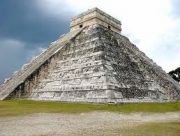Mexican archaeologists discovered a pre-Columbian grave containing human skeletal remains along with relics of a “sacred tree” near the archaeological site of the Great Temple of Tenochtitlan in the historical downtown area of Mexico City, the Mexican National Anthropology and History Institute, or INAH, said.
Found in the burial ground dating back more than 500 years were the complete skeleton of a woman and over a thousand human bones of children, young people and adults.
The discovery is “the only one of its kind” from the Mexica culture, the archaeologist heading INAH’s Urban Archaeological Program, Raul Barrera Rodriguez, said.
Though other multiple burials have been found in the past, “this is the first where the skeleton of an adult is accompanied by bones and bone fragments from humans of different ages,” Barrera said.
Apart from the grave, the specialists found a circular structure of red volcanic rock with a tree trunk in its center that, according to the archaeologists, “would be one of the sacred trees” associated with the god of war Huitzilopochtli, one of the chief figures in Mexica cosmogony and one of the deities to whom the Great Temple was dedicated.
The discoveries occurred in an area called Manuel Gamio Plaza in the course of building an access corridor to the archaeological site and to the museum of the Great Temple, the INAH said.
The skeletal remains were found at about 5 meters (16 feet) under street level, and were beneath a floor of basalt slabs laid at a stage of the Great Temple of Tenochtitlan’s construction between the years 1481 and 1486, so that the mass grave dates back to that time, Barrera said.
“The complete skeleton was found on the west side of the burial site, while the rest of the bones were placed around it, some of them grouped in small compositions, particularly in the case of ribs and femurs,” Barrera said.
Found in the burial ground dating back more than 500 years were the complete skeleton of a woman and over a thousand human bones of children, young people and adults.
The discovery is “the only one of its kind” from the Mexica culture, the archaeologist heading INAH’s Urban Archaeological Program, Raul Barrera Rodriguez, said.
Though other multiple burials have been found in the past, “this is the first where the skeleton of an adult is accompanied by bones and bone fragments from humans of different ages,” Barrera said.
Apart from the grave, the specialists found a circular structure of red volcanic rock with a tree trunk in its center that, according to the archaeologists, “would be one of the sacred trees” associated with the god of war Huitzilopochtli, one of the chief figures in Mexica cosmogony and one of the deities to whom the Great Temple was dedicated.
The discoveries occurred in an area called Manuel Gamio Plaza in the course of building an access corridor to the archaeological site and to the museum of the Great Temple, the INAH said.
The skeletal remains were found at about 5 meters (16 feet) under street level, and were beneath a floor of basalt slabs laid at a stage of the Great Temple of Tenochtitlan’s construction between the years 1481 and 1486, so that the mass grave dates back to that time, Barrera said.
“The complete skeleton was found on the west side of the burial site, while the rest of the bones were placed around it, some of them grouped in small compositions, particularly in the case of ribs and femurs,” Barrera said.












No comments:
Post a Comment